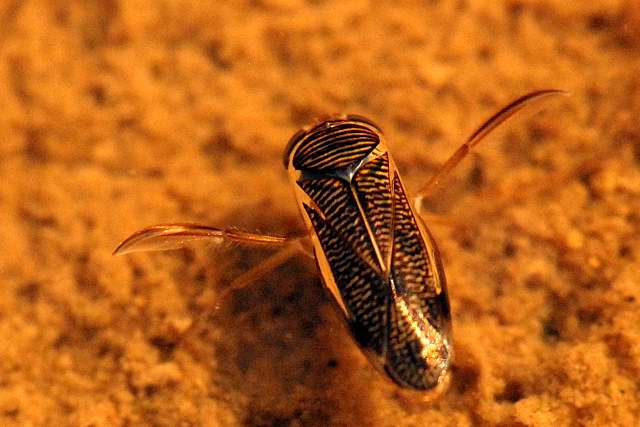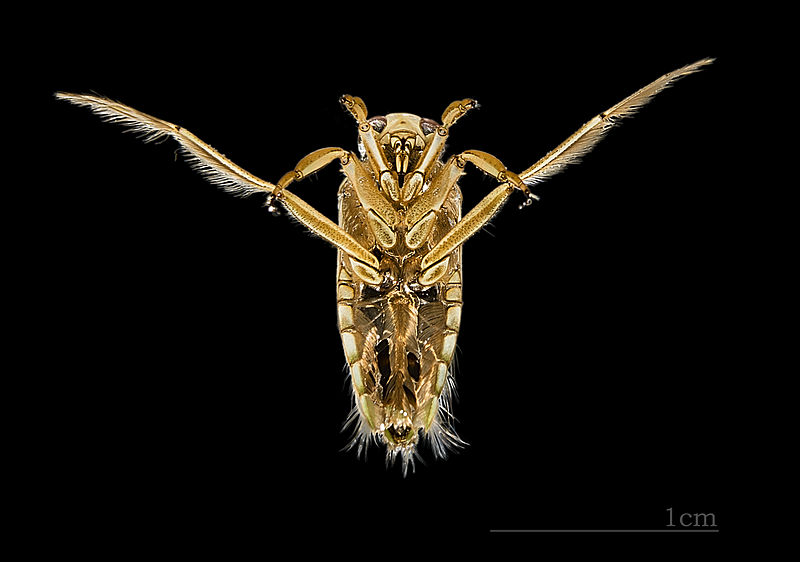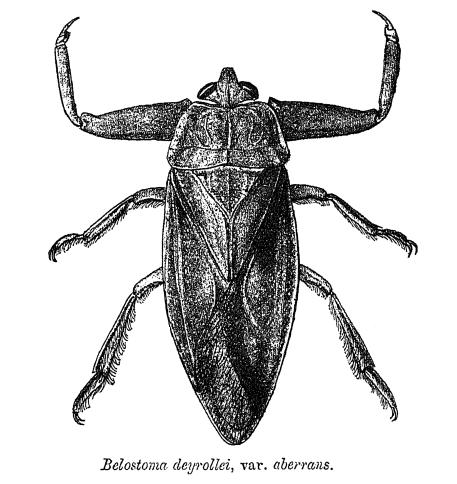Invertebrates 101 Chapter 4
The Insects around the Pond - the Bugs
The last group of insects that really impact the pond environment are the Bugs, distinguished from Beetles by their stabbing, piercing mouthparts. (Beetles chew their food.) You’ve probably noticed the more common bugs, found in ponds across the US - the Water Boatmen, Backswimmers and Water Striders. There’s a fourth group, the Nepoidae, Water Bugs and the ominously named Water Scorpions, which bear mentioning as well.

The Water Boatmen
Water Boatmen, Corixidae, swim right side up, with four long rear legs shaped like oars to row through the water, usually staying near the bottom. They are almost exclusively vegetarian, subsisting mainly on algae and small plants, which they stab with their mouths, injecting saliva then sucking out the “vegetable soup”.
Notonectidae, the Backswimmers, swim upside down with two powerful rear legs, staying at or near the surface. They are capable predators, preying mostly on other insects but not adverse to taking small tadpoles and fish if the occasion arises. Like all True Bugs, Backswimmers are equipped with sharp piercing mouthparts that can inflict a painful “bite” (it’s really a stab) if handled.

The Backswimmer
Water Striders, of the family Gerridae, have one of the coolest modes of transportation ever. Thanks to tens of thousands of tiny, water repellant hairs all over their bodies and legs they skate across the surface of the pond without falling through, and if they accidently do get submerged, the hairs trap air bubbles that they can breathe while they float back up to the surface. They are territorial during mating season, vibrating the surface of the water at specific frequencies to attract mates and drive off other suitors. They hunt by detecting the vibrations of insects and spiders that fall into the water, often working cooperatively in hunting packs when mating pressures are off.

Nepoidae
Finally, there are Nepoidae, the nasty Water Bugs and their kin. Water Scorpions, named for their superficial similarity to true scorpions, have large, sharp forelegs and a long “tail” that’s actually a modified siphon tube. As if the needle points on their predatory forelegs weren’t painful enough, these formidable hunters then stab their prey – or a finger – with a syringe-like rostrum, injecting powerful enzymes that liquefy their meal. Formidable predators, the largest members of this group have been known to take not only fish, frogs and crayfish but even small turtles and baby snakes. As befits such an impressive insect, the largest true bug in the world, our North American species of Giant Water Bugs exhibits some pretty sophisticated parenting behavior. In some species the females lay their eggs on the backs of the males who care for them until hatching. In others, eggs are laid just above the surface of the water and the males guard them, keeping them moist by periodically splashing the brood. Water Bugs may “play dead” when approached by a predator, or a human, often leading to one of the most painful bites of any insect when they “revive” in your hand.
The last group of insects that really impact the pond environment are the Bugs, distinguished from Beetles by their stabbing, piercing mouthparts. (Beetles chew their food.) You’ve probably noticed the more common bugs, found in ponds across the US - the Water Boatmen, Backswimmers and Water Striders. There’s a fourth group, the Nepoidae, Water Bugs and the ominously named Water Scorpions, which bear mentioning as well.

The Water Boatmen
Water Boatmen, Corixidae, swim right side up, with four long rear legs shaped like oars to row through the water, usually staying near the bottom. They are almost exclusively vegetarian, subsisting mainly on algae and small plants, which they stab with their mouths, injecting saliva then sucking out the “vegetable soup”.
Notonectidae, the Backswimmers, swim upside down with two powerful rear legs, staying at or near the surface. They are capable predators, preying mostly on other insects but not adverse to taking small tadpoles and fish if the occasion arises. Like all True Bugs, Backswimmers are equipped with sharp piercing mouthparts that can inflict a painful “bite” (it’s really a stab) if handled.

The Backswimmer
Water Striders, of the family Gerridae, have one of the coolest modes of transportation ever. Thanks to tens of thousands of tiny, water repellant hairs all over their bodies and legs they skate across the surface of the pond without falling through, and if they accidently do get submerged, the hairs trap air bubbles that they can breathe while they float back up to the surface. They are territorial during mating season, vibrating the surface of the water at specific frequencies to attract mates and drive off other suitors. They hunt by detecting the vibrations of insects and spiders that fall into the water, often working cooperatively in hunting packs when mating pressures are off.

Nepoidae
Finally, there are Nepoidae, the nasty Water Bugs and their kin. Water Scorpions, named for their superficial similarity to true scorpions, have large, sharp forelegs and a long “tail” that’s actually a modified siphon tube. As if the needle points on their predatory forelegs weren’t painful enough, these formidable hunters then stab their prey – or a finger – with a syringe-like rostrum, injecting powerful enzymes that liquefy their meal. Formidable predators, the largest members of this group have been known to take not only fish, frogs and crayfish but even small turtles and baby snakes. As befits such an impressive insect, the largest true bug in the world, our North American species of Giant Water Bugs exhibits some pretty sophisticated parenting behavior. In some species the females lay their eggs on the backs of the males who care for them until hatching. In others, eggs are laid just above the surface of the water and the males guard them, keeping them moist by periodically splashing the brood. Water Bugs may “play dead” when approached by a predator, or a human, often leading to one of the most painful bites of any insect when they “revive” in your hand.




